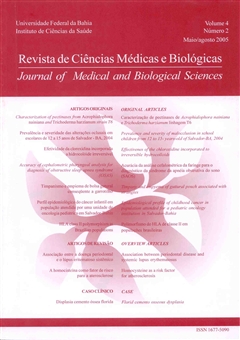Effectivenes of the chloroxidine incorporated to irreversible hydrocolloids
DOI:
https://doi.org/10.9771/cmbio.v4i2.4182Keywords:
chloroxidine - effectiveness, irreversible hydrocolloids, crossed infection - control.Abstract
It is important to prevent the occurrence of crossed infection between the odontologic office and the prosthesis laboratory, transmitted by contaminated molds. Literature recommends the use of substances for the disinfection of molds and models. Products for molding containing chloroxidine in their formula are available on the market. The objective of this study was the evaluation of the antibacterial activity of irreversible hydrocolloids (alginate) containing chloroxidine in samples of saliva. Tests of diffusion of the alginate disk in agar BHI and elution of the disk in broth BHI were made, using samples of alginate with and without chloroxidine and saliva. The halo formation of bacterial growth inhibition and the absence of disturbance in the test tube with alginate containing chloroxidine were observed, confirming the antibacterial activity of the product. In the controls with alginate without chloroxidine, the halo of growth inhibition or the absence of disturbance did not occur. The results gave evidence of the growth inhibition of saliva bacteria by the alginate containing chloroxidine, being able to become an option for the control of crossed infection in odontologic offices and prosthesis laboratories.Downloads
Download data is not yet available.
Downloads
Published
2005-01-02
How to Cite
Moreira, A. C. A., & Cruz, J. F. W. (2005). Effectivenes of the chloroxidine incorporated to irreversible hydrocolloids. Journal of Medical and Biological Sciences, 4(2), 113–117. https://doi.org/10.9771/cmbio.v4i2.4182
Issue
Section
ORIGINAL ARTICLES
License
The Journal of Medical and Biological Sciences reserves all copyrights of published works, including translations, allowing, however, their subsequent reproduction as transcription, with proper citation of source, through the Creative Commons license. The periodical has free and free access.


